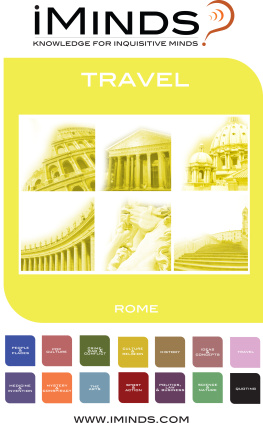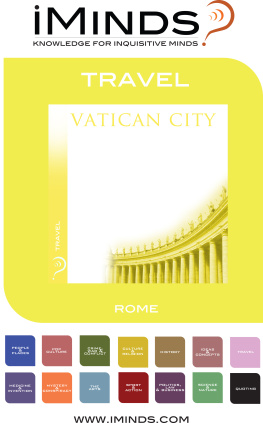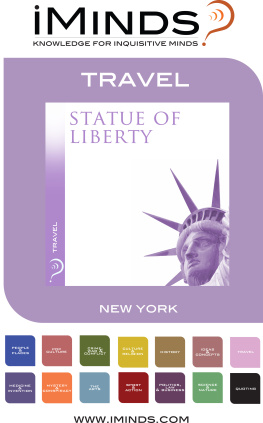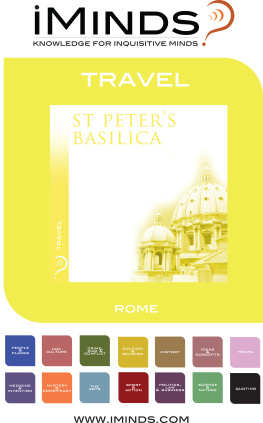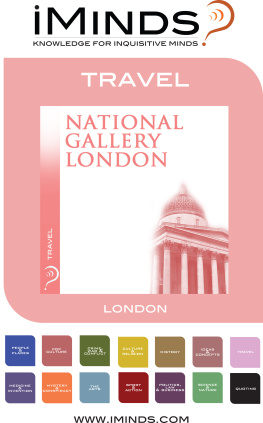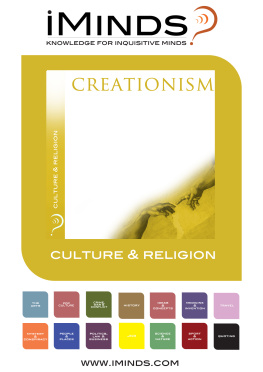iMinds - Rome
Here you can read online iMinds - Rome full text of the book (entire story) in english for free. Download pdf and epub, get meaning, cover and reviews about this ebook. City: Mosman;Rome (Italy);Italy;Rome, year: 2009, publisher: iMinds Pty Limited, genre: Religion. Description of the work, (preface) as well as reviews are available. Best literature library LitArk.com created for fans of good reading and offers a wide selection of genres:
Romance novel
Science fiction
Adventure
Detective
Science
History
Home and family
Prose
Art
Politics
Computer
Non-fiction
Religion
Business
Children
Humor
Choose a favorite category and find really read worthwhile books. Enjoy immersion in the world of imagination, feel the emotions of the characters or learn something new for yourself, make an fascinating discovery.
Rome: summary, description and annotation
We offer to read an annotation, description, summary or preface (depends on what the author of the book "Rome" wrote himself). If you haven't found the necessary information about the book — write in the comments, we will try to find it.
Rome — read online for free the complete book (whole text) full work
Below is the text of the book, divided by pages. System saving the place of the last page read, allows you to conveniently read the book "Rome" online for free, without having to search again every time where you left off. Put a bookmark, and you can go to the page where you finished reading at any time.
Font size:
Interval:
Bookmark:
TRAVEL
Rome
2009 by iMinds Pty Ltd.
All Rights Reserved.

Two thousand years ago the mighty Roman Empire spanned most of Europe, Asia Minor and North Africa. At its heart was the capital city of Rome, the city to which all roads led. Inside this city, the great ruins of the Colosseum are a lasting reminder of the majesty of this great empire. But the gigantic sports arena that is the Colosseum also reveals a dark side of ancient Rome. For the arenas purpose was as a ground for gladiatorial combat. And in its wildly popular four-hundred-year history, the Colosseum would witness the deaths of thousands of humans and animals.
The Colosseum was built by the Emperor Vespasian between 72 and 80AD. It was built from Travertine stone and its builders were brought to Rome from Judaea. After a revolt in Judaea was suppressed by the Roman government, a large amount of Jews were brought to Rome as slaves to construct the arena. Vespasian had it built in the grounds of the Domus Aurea, or Golden House. The Golden House was built by the emperor Nero in the first century. It was actually a collection of many buildings over a great area. The ruins of many of these can still be visited today on the Esquiline Hill next to the Colosseum. Vespasian belonged to the Flavian dynasty, and so the Colosseum was originally called the Flavian Amphitheatre.
This amphitheatre was a mighty and impressive building in its day. The outer walls of the Colosseum have three levels of arches. On the bottom level are Ionic columns and on the upper levels there are Doric and Corinthian arches. Together they form the three classical types of arches. The visitor to the Colosseum may wonder at its architectural prowess from the outside. But the interior is just as impressive. Inside it was lined with marble and there was an array of marble statues in the niches of the second and third storeys. The Colosseum was constructed to seat 50,000 spectators and for comfort from the strong Italian sun there was a canvas awning to cover the crowd.
The stadium was designed as a place where the action could be witnessed 360 degrees around the arena floor. And its interior can really be divided into three different parts: the arena, the cavea and the podium. The arena was where all the action took place. It consisted of a wooden floor that was covered in sand to soak up the blood and ensure the gladiators didnt slip. It had trapdoors that led down to underground chambers and passageways. From here animals were hoisted up in cages through the use of pulleys for maximum drama. The cavea was where most spectators sat. There were three tiers. On the lowest of these sat the knights. On the middle tier sat the wealthy citizens, who had a good view from which to watch the games and on the top tier sat the plebeians, or ordinary folk. The podium stood apart from all three tiers. It was specially-made for comfort and ease of viewing and it housed the emperor, senators and VIPs.
From its inception in 80AD the Colosseum was used extensively. Following its official opening there followed one hundred days of celebratory games. They included the killing of an extraordinary five thousand wild beasts. But this grand opening was not the most bloodshed the Colosseum was to witness in its lifetime. Emperor Trajan, who reigned from 98 until 117, held one-hundred-and-seventeen days of games in an extravaganza that saw nine thousand gladiators and ten thousand animals take to the arena. As the crowd readied itself for the drama of the days events a trumpet would blast. Then out would march the gladiators, swords and spears in hand. Before fighting they would face the emperor and exclaim, Hail Caesar! We who are about to die salute you. And the chance was the gladiators would die. If a gladiator battled on to the end, his life was in the hands of the crowd and the magistrate. If the spectators wanted the gladiator to survive, they would put their thumbs up. A thumbs down signal meant the gladiator should be killed. Such was the gruesome beginning to the hand signals we know today.
The action that took place in the arena was wide-ranging and thus kept Romans entertained for hundreds of years. Slaves and the very occasional volunteer would be forced to fight each other and wild animals. If they tried to retreat, whips and red-hot irons soon propelled them towards their destiny. As well as this, women and men who had broken the law could be thrown into the Colosseum as easy bait to ravenous lions that had been deliberately starved. In even more extravagant circumstances, the Colosseum could be flooded and ships were brought in for slaves to re-enact epic sea battles. The sword-fights that took place aboard these ships were real, as were the deaths. So there are recorded cases of the wrong side winning the battle as the gladiators fought to save themselves regardless of whether they represented the winners or losers.
With so much interest in the Colosseum many people do not realise that there were other similar stadiums in Rome in ancient times. The Colosseum is undoubtedly the most famous. But did you know that it was not actually the largest? That honour goes to the Circo Massimo, a gargantuan 200,000 seat stadium not far from the Colosseum. Today the site of the Circo Massimo is mostly a stretch of grass with a few crumbling ruins. Our usage of the term Colosseum to describe Romes favourite stadium stems from the medieval period. And it wasnt the arena that was called colossal, but a giant nearby statue of Nero!
It would be wrong to assume that all Romans approved of the killing of people and animals as a sport. But the overwhelming popularity of the Colosseum shows that few had qualms about its morality.But as a type of sport, gladiatorial combat gradually decreased in popularity. The changing of Roman cultural practices due to an increase in Christianity is one reason for the end of gladiator sports. And after four nearly four centuries the final games in the Colosseum were mentioned in the 430s. This building has not been used for such practices since, but its legacy lives on! Many a modern sports stadium comes from the layout of the Colosseum.
Over the millennia the culture of ancient Rome has been a source of fascination for many. In the eighth century, English scholar Bede wrote that while the Colosseum stands, Rome shall stand, but when the Colosseum falls, Rome shall fall and when Rome falls, the world will end. And nearly one thousand years after the final games the Renaissance made interest in the ancient world fashionable again. As part of this zeitgeist, those in power took stones from the Colosseum to build their own palaces. It was only as late as the 1700s that Pope Benedict XIV sent out an order that the Colosseum was to be preserved as a monument to Christian martyrs. This was due to the fact that a number of Christian martyrs were fed to the lions for practising their illegal faith.
Throughout its long history, the Colosseum has suffered a number of damages. There have been numerous earthquakes that have caused the building to become frail. And today pollution and vibrations from traffic and the metro cause continued damage on this mighty stone structure. But despite its hardship the Colosseum still stands as an ancient marvel to engross the eager tourist.

Which Roman building has been used as a military fortress, a Christian church, and a fish and vegetable market during the course of its long life? The answer is the Pantheon, whose majestic columns and magnificent dome ensure its place as one of Romes most impressive architectural feats. Its ability to be transformed to suit different religions and cultures has ensured it has lasted for millennia.
Next pageFont size:
Interval:
Bookmark:
Similar books «Rome»
Look at similar books to Rome. We have selected literature similar in name and meaning in the hope of providing readers with more options to find new, interesting, not yet read works.
Discussion, reviews of the book Rome and just readers' own opinions. Leave your comments, write what you think about the work, its meaning or the main characters. Specify what exactly you liked and what you didn't like, and why you think so.

